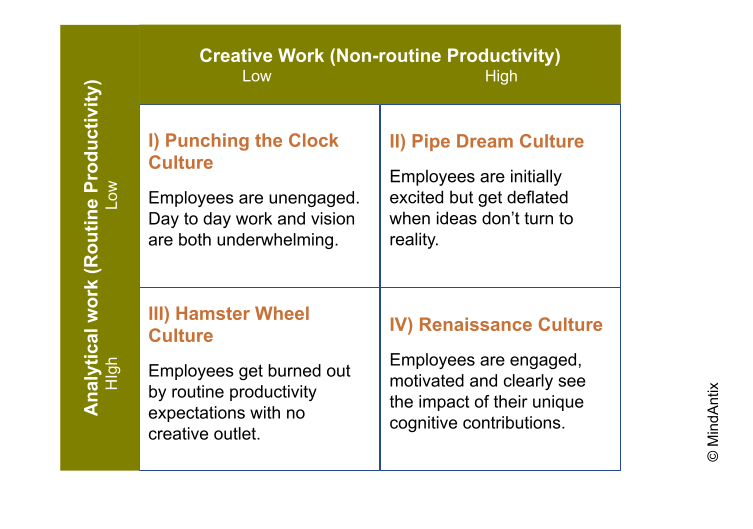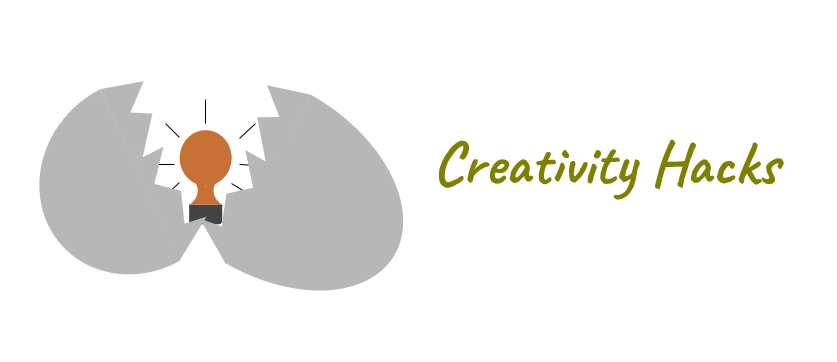Dr. Pronita Mehrotra and Dr. Sandeep Krishnamurthy
As we head deeper into the 21st century with increasing use of AI and automation taking away routine work, it’s no surprise that creativity is becoming a highly valued skill in the modern workforce.
In most places, employees have to do both creative and routine work. They have to create new products or services which require creativity, but they also have to do work within structured processes which is more routine in nature. To be successful, organizations have to create a healthy balance between creative and routine work.
But what happens when creativity is insufficiently or incorrectly used in an organization?
When creativity is misapplied, it can lead to poorer work cultures. The kinds of tasks people engage in their day to day work plays a role in how they perceive the work culture. We can classify organizational cultures based on the relative emphasis on routine and non-routine productivity (see figure above). While no organization of a reasonable size lies completely in a single quadrant, this framework can be a helpful tool for business leaders to identify where their organization or team lies.
Punching The Clock Culture
If a single emotion were to describe employees in this quadrant, it would be ‘boredom’. Much like the culture satirized in the hit series, The Office, work doesn’t require any creative input, is not intellectually stimulating and doesn’t provide skill growth.
Job design here is so constricted by process that there is almost no autonomy for the individual. When employees don’t have a reasonable say in designing their work or opportunities for their creative ideas to be included, they are no longer intrinsically motivated and don’t feel invested in their work. Since the culture supports simple routine work, automation can outperform the individual work here. Such companies are bound to become obsolete in a short period of time, as automation accelerates.
Unfortunately, this kind of culture is not uncommon. When work is primarily routine, like in Call Centers, leaders have to find ways to empower their employees and keep them motivated. Zappos tried (at that time) a radical approach to inspire its customer service employees. Employees were empowered to use their imagination instead of following a script to delight their customers. By explicitly adding creativity into the equation, Zappos was able to convert dull and unpleasant tasks into something fun and delightful, and dramatically reduced employee turnover.
Pipe Dream Culture
If your company routinely creates product roadmaps that take twice as long to ship with half the features, there is a good chance that you lie in this quadrant. It’s an indication that your organization misunderstands creativity and places a higher value on being visionaries as opposed to being innovators. Creativity is imagination tied with practicality – it requires hard work to research, analyze and prototype to prove that an idea would be both novel and useful.
Lily Robotics, a camera drone company, launched in 2015 with a breathtaking promotional video of its self-driving drone that could automatically follow you and take videos. The concept garnered a lot of attention and the company raised close to $50 million in pre-orders and institutional money. But, a year and a half later, the company shut down. It turned out that there were significant technical challenges in building all of the features the video promised. This, and countless other similar examples, show how a misunderstanding of creativity can lead to failure. If the founders and investors had spent more time analyzing whether the idea is workable or not, they would have saved everyone time and money.
Paradoxically, organizations built around a pipe dream culture suffer from enough critical flaws that they are doomed to failure even without the impact of AI and automation.
To avoid a pipe dream culture, leaders have to strive for a healthy balance between optimism and skepticism, between keeping an open mind to new ideas and spending time to evaluate those ideas. In fact, the more original an idea, the more time leaders need to spend in ensuring that the novel aspects are indeed workable.
Hamster Wheel Culture
If your employees are working long and hard to meet never-ending deadlines, they are likely in the third quadrant where productivity goals overwhelm them. While their work might offer opportunities to be creative, the constant pressure leaves them with no time to sit back, reflect and think of new approaches. They live in the here and now.
When Covid hit and organizations started moving to remote work, leaders defaulted to enhancing routine productivity instead of incentivizing innovation and inadvertently pushed their organizations deeper into the Hamster Wheel culture. Research on global companies found that during the pandemic employees worked longer, spent more time in virtual meetings and sent more chat messages and emails. However, this came at a cost — most employees felt overworked and exhausted.
To get out of the Hamster Wheel culture, leaders need to provide time and autonomy for employees to exercise their creativity. They need to track creative work differently from routine work, and they need to ensure that all employees regardless of their role or place in hierarchy contribute to the creative capital.
Renaissance Culture
This is the ideal Goldilocks zone – where both creativity and productivity are balanced optimally. Employees in this quadrant are aligned with the company vision and can clearly see their own contributions towards it. Being intrinsically motivated, they make discretionary effort to see ideas come to fruition. The organization has an optimal blend of routine and non-routine work – enough focus on the routine to sustain current operations combined with the right proportion of non-routine work to build for the future.
While the routine/non-routine balance is one aspect of the organization’s culture, it is an important yet overlooked dimension. By evaluating where their current culture lies, leaders can devise strategies to shift their cultures towards the ideal Renaissance culture. By infusing more creativity and autonomy correctly, leaders can tap into employees’ intrinsic motivation and thereby improve employee experience.
We’d love to hear from you! Take our short, confidential survey to share your organizational culture experience.




